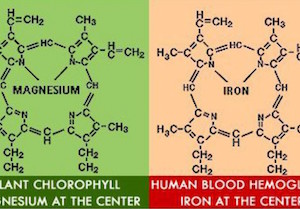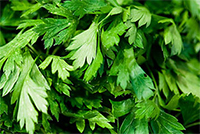



Parsley
Avoid parsley
(Petroselinum crispum)
AVOID: Parsley is high in oxalates. If one suffers from kidney stones watch your intake of oxalates.
According to one PKD'r
Parsley is quite high in Vitamin K, a vitamin responsible for increasing blood coagulation.
Blood coagulation differs slightly
from the way that aspirin works. Aspirin works to keep platelets from clumping together but
another anti-coagulant, Coumadin®, works
on a different coagulation pathway. Some people out there who have had strokes or have a
history of clotting take Coumadin®, which is
a strong anti-coagulant. Vitamin K is the antidote for this medication. People with high intakes
of vitamin K can offset the effects
of Coumadin® so it's important to keep in mind. This may be why parsley clumps together in a smoothie,
and as it is juiced, it coagulates."
Taken from this article.
Parsley lowers blood pressure; it is a wonderful blood pressure regulator and super alkaline producing; it is loaded with chlorophyll which aids the body to detoxify; it freshens breath; it might be an alternative for frequent urinary tract infections; apigenin contained in parsley might prevent bone loss.
Some have tried carrot-parsley juice to help squelch a sweet tooth.
It is a mild diuretic but gentle in its effect on kidneys. It does not cause potassium depletion. Parsley is also a source of alpha-linolenic acid, an important essential fatty acid. It is an adequate source of beta carotene, which the body needs for the correct use of protein. This nutrient will benefit the liver and also protect the lungs and colon. When tested in laboratory research, chlorophyll from parsley showed slight anti-bacterial and anti-fungal activity.
Parsley contains traces of B12 producing compounds. Fluorine is abundantly found in parsley. Fluorine has an entirely different molecular structure from chemically-produced fluoride. Tooth decay results from a shortage of fluorine, not fluoride. It is the combination of calcium and fluorine which creates a very hard protective surface on teeth and bones. Fluorine also protects the body from infectious invasion, germs and viruses. Parsley is a source for vitamin C and iron.
Parsley & Olives helps bone density
Apigenin prevents bone loss.
"Apigenin inhibits osteoblastogenesis and osteoclastogenesis and prevents bone loss in ovariectomized mice
Our findings indicate that apigenin (in olives & parsley) it may have critical effects on
bone maintenance in vivo."
Apigenin has a relaxing effect on the body which can lower blood pressure.
Food Sources of Apigenin
It is found in many fruits, vegetables and herbs, the amount varies. The richest natural sources are:
Artichokes
Basil avoid
Chamomile
Cloves avoid
Coriander
Lemon Balm
Parsley avoid
Peppermint
Olives caution
Oregano
Spinach avoid
Thyme

Chlorophyll in Parsley Juice
Many potent food alkalizers are filled with chlorophyll: cereal grass juice, kale juice, leafy greens juice. Continue to avoid chlorella, green algae and other scums. These may be harmful to PLD. Chlorophyll is said to have a similar structure to that of blood hemoglobin. The chlorophyll molecule and the hemoglobin molecule are almost identical in shape. At their center hemoglobin has iron whereas chlorophyll has magnesium. This similarity was first suggested in 1855 by Verdel. Consuming chlorophyll allows one to capture sunlight as energy according to one recent theory. Can insects do it?
A researcher in Ulm, Germany, Andrei Sommer,
has written a research article about light,
Burst of light speeds up healing by turbocharging our cells.
"The light causes mitochondria, the cell's powerhouses, to produce more ATP,
a compound that provides the cells' energy."
The medical article is available for your review.
This is all taken in with Dr. Grantham's discovery, that the fluid inside a cyst is filled with the same or a very similar chemical as the plant forskolin, coleus. We with PKD/PLD may have inherited by DNA gone awry, plant liquid that may help us heal.
